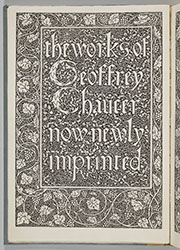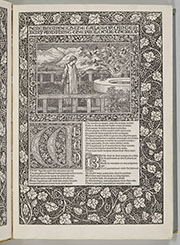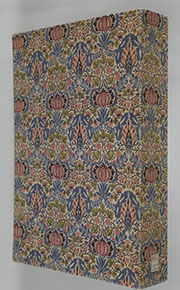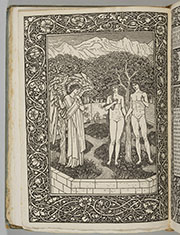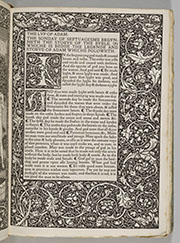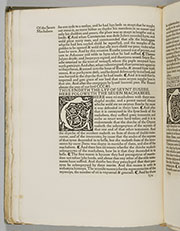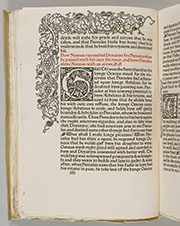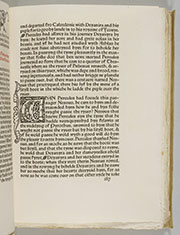70th Anniversary Commemorative Exhibit "A Treasure Box of Books - The 70-year History of the National Diet Library and Its Collections"
- A Treasure Box of Books
- Part 2 Diverse Collections
- Chapter 1 Beautiful Books and Rare Books
- Section 1 Beautiful Western Books
Part 2 Chapter 1 Section 1 Beautiful Western Books
This section includes exhibits of photo collections of traditional European libraries which have long histories and reproductions of decorated medieval Western manuscripts, as well as the Doves Press "The English Bible" and the Kelmscott Press "The works of Geoffrey Chaucer, now newly imprinted", which are both considered ideal examples of modern printed books.
30 Temples of knowledge, [photographs by] Ahmet Ertuğ, Ertuğ & Kocabiyik, 2009 [YP51-B260]
A collection of photos of 30 historical Western libraries by a Turkish photographer who is also an architect. The collection consists of 100 clear photos taken with a large format camera. This is one of limited editions from his own publishing house -- and great care has been taken to ensure to avoid stitching through the images.
- History of Western libraries
-
In the medieval Western world, most large collections of books were mainly found in the libraries of monasteries. These libraries also often had a scriptorium where transcriptions of manuscripts were produced.
At the end of the 12th century, manuscripts also began to be produced commercially and nobles and aristocrats began using their abundant financial resources to employ transcribers and artists to produce luxurious manuscripts. These collections of books compiled by feudal lords and other wealthy individuals often became the basis for what would later develop into the collections of national and university libraries.
This resulted in a shift from the small reading spaces where books were secured to reading pedestals and shelves with chains, to Baroque-style libraries with large halls and massive walls of books, and further to enormous libraries where book vaults and stacks were separated from reading rooms.
31 Beri-kou no itomo utsukushiki seibo jitosho, (Les Très belles heures de Notre-Dame), Iwanami Shoten, c1994 [YP51-A394]
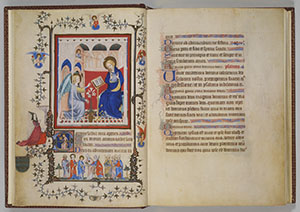
Jitosho (a Book of Hours) is a private prayer book composed of schedule prayers, a calendar of saints' days, and prayers for the dead, the majority of which feature beautiful miniatures and ornamentation. Jean, Duke of Berry, of medieval France, is known for commissioning the production of and collecting many magnificent examples of books of hours. The exhibit is a reproduction (the original "Les Très belles heures de Notre-Dame" is held by the Bibliothèque nationale de France) of the first half of a work whose production was not completed.
32 The English Bible, The Doves Press, 1903-1905 [WB41-68]
vol. 1 1903, vol. 2 1903, vol. 3 1904, vol. 4 1904
This is an English translation of the bible commissioned by James I, King of England, and completed in 1611. The concise expressions, sublime prosody, and beautiful phrasing of this version had a significant impact on modern English prose. In 1900, T. J. Cobden-Sanderson, who established the private press the Doves Press, used the Doves printing type, which was based on Nicolaus Jenson's Roman Type, to produce a version with a restrained beauty.
33 The works of Geoffrey Chaucer, now newly imprinted, Kelmscott Press, 1896 [WB41-41]
Said to be the masterpiece of the Kelmscott Press publications. William Morris produced the woodblock print title-page, border decorations and 26 decorative initials and the artist Edward Burne-Jones produced the 87 illustrations. The Troy typeface proved too large, so the smaller Chaucer Type version was used for this work.
- Kelmscott Press
-
Kelmscott Press was a private press established by English artist, poet, writer, and social thinker William Morris in the Hammersmith suburb of London in 1891. The press produced 53 books in 65 volumes until 1898, two years after Morris' death.
The press sought to produce "ideal books" through a variety of means, learning much from medieval manuscripts and Renaissance books: carefully selecting inks, using handmade paper, incorporating beautiful double page prints, and printing using hand presses.
In addition to designing many decorative initials and borders, the press also produced several original printing types including the Roman Typeface Golden Type, Gothic Typeface Troy Type, and Chaucer Type, which was a condensed version of the Golden Type.
34 The golden legend of Master William Caxton done anew, v.1, v.2, Kelmscott Press, 1892 [WB41-7]
A collection of legends of various saints established in the Middle Ages, the original source text was produced in 1483 by English printer William Caxton. The name of the first typeface designed by William Morris, Golden Type, was derived from the name of this exhibited material. This book was originally planned to be the first book printed by Kelmscott Press, however the paper was unsuitable for the printing and so the printing was delayed until larger size paper was available. This book was the first use of a woodcut print title page designed by Morris.
35 The recuyell of the historyes of Troye, v.2/3, Kelmscott Press, 1892 [WB41-8]
This was the first book printed by Kelmscott Press, using Troy Type for the main text and Chaucer Type for the index and other sections, based on the original produced around the year 1473 by William Caxton. The medieval-style tale was long one of William Morris's favorite books, and he produced a large number of text decorations and designs for the book.
36 The order of chivalry, Kelmscott Press, 1892-1893 [WB41-13]
This book, printed by Kelmscott Press, was the first to use Chaucer Type for the main text. This work was an attempt to faithfully reproduce the English prose paraphrase produced by William Caxton in 1484. Thereafter, an English verse translation from the original French by William Morris was added, with the finished product being printed as a collection in one volume of the Caxton translation, the French original, and the Morris translation.
37 The wood beyond the world by William Morris, Kelmscott Press, 1894 [WB41-28]
This work is a prose romance set in a fictitious medieval world written by William Morris, who was an author as well as a printer. It is said that the original manuscript included instructions for the inclusion of decorative text and other features as it was written with the intent for it to be published by Kelmscott Press. Ten new types of border decorations were used for the first time in this book.

